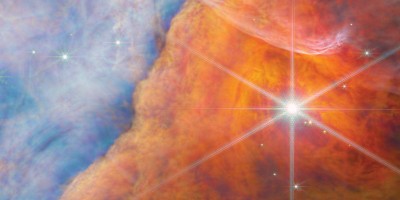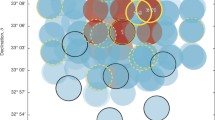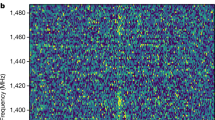Abstract
Fast radio bursts are extragalactic, sub-millisecond radio impulses of unknown origin1,2. Their dispersion measures, which quantify the observed frequency-dependent dispersive delays in terms of free-electron column densities, greatly exceed predictions from models3 of the Milky Way interstellar medium. The excess dispersions are probably accrued as fast radio bursts propagate through their host galaxies, gaseous galactic halos and the intergalactic medium4,5. Despite extensive follow-up observations of the published sample of 72 burst sources6, only two have been observed to repeat7,8, and it is unknown whether the remainder are truly one-off events. Here I show that the volumetric occurrence rate of the fast radio bursts that have not been observed to repeat thus far probably exceeds the rates of candidate cataclysmic progenitor events, and also probably exceeds the birth rates of candidate compact-object sources. This analysis is based on the high detection rate of bursts with low dispersion measures by the Canadian Hydrogen Intensity Mapping Experiment (CHIME)9. Within the existing suite of astrophysical scenarios for fast radio burst progenitors, I conclude that most observed cases must originate from sources that emit several bursts over their lifetimes.


Similar content being viewed by others
Data Availability
The datasets analysed during the current study are available from the FRB Catalogue: http://frbcat.org/.
Code Availability
Custom code used in this study is available at https://github.com/VR-DSA/frb_rate.
References
Thornton, D. et al. A population of fast radio bursts at cosmological distances. Nature 341, 53–56 (2013).
Ravi, V. The observed properties of fast radio bursts. Mon. Not. R. Astron. Soc. 482, 1966–1978 (2019).
Cordes, J. M. & Lazio, T. J. W. NE2001. I. A new model for the galactic distribution of free electrons and its fluctuations. Preprint at http://arxiv.org/abs/astroph/0207156 (2002).
Shull, J. M. & Danforth, C. W. The dispersion of fast radio bursts from a structured intergalactic medium at redshifts z < 1.5. Astrophys. J. Lett. 852, 11 (2018).
Prochaska, J. X. & Zheng, Y. Probing galactic haloes with fast radio bursts. Mon. Not. R. Astron. Soc. 485, 648–665 (2019).
Petroff, E. et al. FRBCAT: The fast radio burst catalogue. Publ. Astron. Soc. Aust. 33, e045 (2016).
Spitler, L. et al. A repeating fast radio burst. Nature 531, 202–205 (2016).
Amiri, M. et al. A second source of repeating fast radio bursts. Nature 566, 235–238 (2019).
Amiri, M. et al. Observations of fast radio bursts at frequencies down to 400 megahertz. Nature 566, 230–234 (2019).
Shannon, R. M. et al. The dispersion−brightness relation for fast radio bursts from a wide-field survey. Nature 562, 386–390 (2018).
Kulkarni, S. R., Ofek, E. O., Neill, J. D., Zheng, Z. & Juric, M. Giant sparks at cosmological distances? Astrophys. J. 797, 70 (2014).
Yang, Y.-P. & Zhang, B. Extracting host galaxy dispersion measure and constraining cosmological parameters using fast radio burst data. Astrophys. J. Lett. 830, L31 (2016).
Gehrels, N. Confidence limits for small numbers of events in astrophysical data. Astrophys. J. 303, 336–346 (1986).
Platts, E. et al. A living theory catalogue for fast radio bursts. Preprint at https://arxiv.org/abs/1810.05836 (2018).
Xu, J. & Han, J. L. Extragalactic dispersion measures of fast radio bursts. Res. Astron. Astrophys. 15, 1629 (2015).
Walker, C. R. H., Ma, Y.-Z. & Breton, R. P. Constraining redshifts of unlocalised fast radio bursts. Preprint at https://arxiv.org/abs/1804.01548 (2018).
Li, D., Yalinewich, A. & Breysse, P. C. Statistical inference of the distance to ASKAP FRBs. Preprint at https://arxiv.org/abs/1902.10120 (2019).
Kashiyama, K., Ioka, K. & Meszaros, P. Cosmological fast radio bursts from binary white dwarf mergers. Astrophys. J. Lett. 776, 39 (2013).
Totani, T. Cosmological fast radio bursts from binary neutron star mergers. Publ. Astron. Soc. Jpn 65, L12 (2013).
Falcke, H. & Rezzolla, L. Fast radio bursts: the last sign of supramassive neutron stars. Astron. Astrophys. 562, A137 (2013).
Abbott, B. P. et al. GW170817: observation of gravitational waves from a binary neutron star inspiral. Phys. Rev. Lett. 119, 161101 (2017).
Ruiter, A. J., Belczynski, K., Benacquista, M. & Holley-Bockelmann, K. The contribution of halo white dwarf binaries to the laser interferometer space antenna signal. Astrophys. J. 693, 383–387 (2009).
Badenes, C. & Maoz, D. The merger rate of binary white dwarfs in the galactic disk. Astrophys. J. Lett. 749, 11 (2012).
Moriya, T. J. Radio transients from accretion-induced collapse of white dwarfs. Astrophys. J. Lett. 830, 38 (2016).
Ruiter, A. J. et al. On the formation of neutron stars via accretion-induced collapse in binaries. Mon. Not. R. Astron. Soc. 484, 698–711 (2019).
Taylor, M. et al. The core collapse supernova rate from the SDSS-II supernova survey. Astrophys. J. 792, 135 (2014).
Kelly, P. L. & Kirshner, R. P. Core-collapse supernovae and host galaxy stellar populations. Astrophys. J. 759, 107 (2012).
Keane, E. F. & Kramer, M. On the birthrates of galactic neutron stars. Mon. Not. R. Astron. Soc. 391, 2009–2016 (2008).
Caleb, M., Stappers, B. W., Rajwade, K. & Flynn, C. Are all fast radio bursts repeating sources? Mon. Not. R. Astron. Soc. 485, 5500–5508 (2019).
James, C. W. Limit on the population of repeating fast radio bursts from the ASKAP/CRAFT lat50 survey. Preprint at https://arxiv.org/abs/1902.04932 (2019).
Nicholl, M. et al. Empirical constraints on the origin of fast radio bursts: volumetric rates and host galaxy demographics as a test of millisecond magnetar connection. Astrophys. J. 843, 84 (2017).
Yao, J. M., Manchester, R. N. & Wang, N. A new electron-density model for estimation of pulsar and FRB distances. Astrophys. J. 835, 29 (2017).
Li, W. et al. Nearby supernova rates from the Lick Observatory Supernova Search—III. The rate-size relation, and the rates as a function of galaxy Hubble type and colour. Mon. Not. R. Astron. Soc. 412, 1473–1507 (2011).
Ofek, E. O. Soft gamma-ray repeaters in nearby galaxies: rate, luminosity function, and fraction among short gamma-ray bursts. Astrophys. J. 659, 339–346 (2007).
Acknowledgements
I thank E. Thomas, C. Bochenek and J.-P. Macquart for discussions. This work made use of the astropy (http://www.astropy.org) Python package. I am supported by a Clay Postdoctoral Fellowship of the Smithsonian Astrophysical Observatory.
Author information
Authors and Affiliations
Corresponding author
Ethics declarations
Competing interests
The author declares no competing interests.
Additional information
Publisher’s note: Springer Nature remains neutral with regard to jurisdictional claims in published maps and institutional affiliations.
Supplementary information
Supplementary Information
Supplementary Figures 1–2.
Rights and permissions
About this article
Cite this article
Ravi, V. The prevalence of repeating fast radio bursts. Nat Astron 3, 928–931 (2019). https://doi.org/10.1038/s41550-019-0831-y
Received:
Accepted:
Published:
Issue Date:
DOI: https://doi.org/10.1038/s41550-019-0831-y
- Springer Nature Limited
This article is cited by
-
An assessment of the association between a fast radio burst and binary neutron star merger
Nature Astronomy (2023)
-
Fast radio bursts at the dawn of the 2020s
The Astronomy and Astrophysics Review (2022)
-
The evolution of binary neutron star post-merger remnants: a review
General Relativity and Gravitation (2021)
-
The physics of fast radio bursts
Science China Physics, Mechanics & Astronomy (2021)
-
The physical mechanisms of fast radio bursts
Nature (2020)





